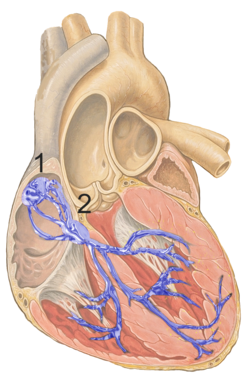
Back Sino-atriale knoop Afrikaans عقدة جيبية أذينية Arabic Sinoatrijski čvor BS Node sinusal Catalan گرێ گیرفانی گوێچکەڵە CKB Sinoatriální uzel Czech Sinusknoten German Nódulo sinoauricular Spanish Nodulu sinoaurikular Basque گره سینوسی- دهلیزی Persian
| Sinoatrial node | |
|---|---|
 Sinoatrial node shown at 1. The rest of the conduction system of the heart is shown in blue. | |
| Details | |
| System | Electrical conduction system of the heart |
| Artery | Sinoatrial nodal artery |
| Identifiers | |
| Latin | nodus sinuatrialis |
| Acronym(s) | SA node |
| MeSH | D012849 |
| TA98 | A12.1.06.003 |
| TA2 | 3953 |
| FMA | 9477 |
| Anatomical terminology | |
The sinoatrial node (also known as the sinuatrial node, SA node or sinus node) is an oval shaped region of special cardiac muscle in the upper back wall of the right atrium made up of cells known as pacemaker cells. The sinus node is approximately 15 mm long, 3 mm wide, and 1 mm thick, located directly below and to the side of the superior vena cava.[1]
These cells can produce an electrical impulse known as a cardiac action potential that travels through the electrical conduction system of the heart, causing it to contract. In a healthy heart, the SA node continuously produces action potentials, setting the rhythm of the heart (sinus rhythm), and so is known as the heart's natural pacemaker. The rate of action potentials produced (and therefore the heart rate) is influenced by the nerves that supply it.[2]
- ^ Hall, John E. (2011). Guyton and Hall textbook of medical physiology (Twelfth ed.). Philadelphia, Pa. p. 115. ISBN 9781416045748.
{{cite book}}: CS1 maint: location missing publisher (link) - ^ Monfredi, O.; Dobrzynski, H.; Mondal, T.; Boyett, M.R.; Morris, G.M. (2010). "The anatomy and physiology of the Sinoatrial Node-A contemporary review". Pacing and Clinical Electrophysiology. 33 (11): 1392–1406. doi:10.1111/j.1540-8159.2010.02838.x. PMID 20946278. S2CID 22207608.
© MMXXIII Rich X Search. We shall prevail. All rights reserved. Rich X Search